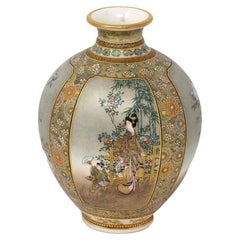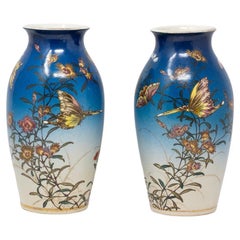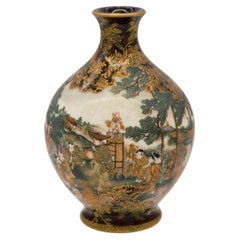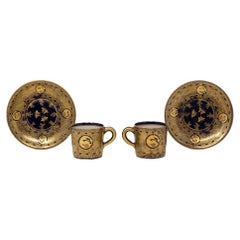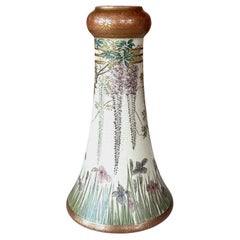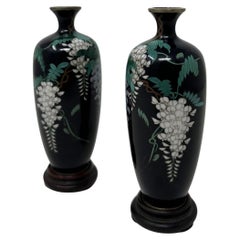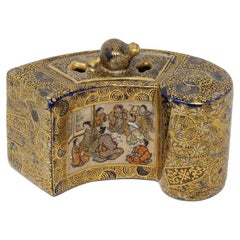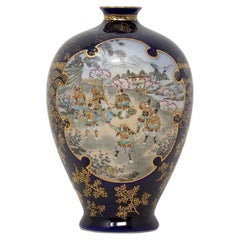Kinkozan Furniture
to
1
18
5
24
10
14
10
3
23
5
4
2
1
18
18
18
24
24
24
10
8,701
3,917
2,534
2,229
Creator: Kinkozan
Antique Japanese Meiji Period (1868-1912) Satsuma Vase by Kinkozan
By Kinkozan
Located in Newark, England
Signed Kinkozan 金光山
From our Japanese collection, we are delighted to offer this Japanese Satsuma Vase by Kinkozan. The vase is potted in globular form with a tightly pinched neck and rolled top rim beautifully decorated with four highly detailed individual panelled scenes. The first a Geisha baring a gilt basket with her child playing with a fan infant of a gilt fence encompassing blossoming foliage and bamboo plants. The second scene depicts two birds, a Red Headed Japanese Wood Pigeon and a white dove in the foreground with a similar gilt fence with blossoming kiku flowers (chrysanthemums). The third scene is painted as a bustling village community with multiple figures going about their daily jobs, a central Palanquins can be seen with two figures carrying a seating figure. To the background a mountainous river landscape can viewed bordering the top left corner. The final scene appears similar to the opposing one with birds swooping high above a polychrome Japanese...
Category
Late 19th Century Japanese Meiji Antique Kinkozan Furniture
Materials
Ceramic, Earthenware, Pottery
Japanese Meiji Period (1868-1912) Satsuma Vase by Kinkozan
By Kinkozan
Located in Newark, England
JAPANESE SATSUMA PROCESSIONAL VASE
From our Japanese collection, we are delighted to introduce to the market this Japanese Satsuma Vase by Kinkozan. The vase with a compressed body ...
Category
Late 19th Century Japanese Meiji Antique Kinkozan Furniture
Materials
Ceramic, Earthenware, Pottery
Unusual Pair of Japanese Meiji Period (1868-1912) Satsuma Vases by Kinkozan
By Kinkozan
Located in Newark, England
Taizan Yohei IX Style
From our Japanese collection we are delighted to offer this pair of Japanese Satsuma Vases by Kinkozan. The Satsuma Vases of baluster shape made from earthenwa...
Category
Early 1900s Japanese Meiji Antique Kinkozan Furniture
Materials
Ceramic, Earthenware, Pottery
Satsuma earthenware vase by kinkozan, Meiji period
By Kinkozan
Located in Tel Aviv - Jaffa, IL
the body of this small marvelous vase is painted with a scene of a puppet show vendor with his wood backpack, on top of the backpack there are toys and dolls, he is surrounded with a group of 6 children, and on the background you can see a village.
on the other side of the vase there is an amazing painting of flowers and on the sides there are two amazing strong pine trees, the amorphous background is decorated in a "Tortoiseshell" color and design that gives it a real character and which is quite rare to see on satsuma pottery.
all the vase is over richly overpainted over the glaze with gold, which gives it its depth and realism.
signed Kyoto Kinkozan zo, and sealed Kinkozan zo
Kyoto’s Satsuma:
The painting technique used in Kyoto’s Satsuma-style ware is said to be the invention of the sixth generation Kinkōzan Sōbei (1824–1884). The Kinkōzan were a famous family of Kyoto Awataguchi potters who made ceramics that were used at Shōren'in, a temple closely tied to the imperial family, and by the shoguns of the Edo government. In fact the shogun is said to have granted them the name Kinkōzan. With the upheavals at the end of the Edo period, however, and the reforms of the subsequent Meiji government, the potters lost their traditional patrons and had to develop new markets.
Just at that time, the visit of a certain Westerner is said to have decided them to embark on overseas trade. By 1870, they had perfected Kyō Satsuma...
Category
1890s Japanese Meiji Antique Kinkozan Furniture
Materials
Gold
Japanese Meiji period (1868-1912) Satsuma Cup and Saucer Pair by Kinkozan
By Kinkozan
Located in Newark, England
PAIR OF CUP AND SAUCERS BY KINKOZAN
MEASUREMENTS
Saucer 10.8cm Diameter x 1.5cm High (4.25 x 0.6 Inches)
Cup 4.6cm High x 6.7cm Long x 5cm Wide (1.8 x 2.64 x 1.97 Inches)
From our ...
Category
Late 19th Century Japanese Meiji Antique Kinkozan Furniture
Materials
Ceramic, Earthenware, Pottery
Fine Japanese Enameled Satsuma Vase by Kinkozan Meiji Period
By Kinkozan
Located in Atlanta, GA
A ceramic satsuma ware vase with very fine surface decoration made by Kinkozan circa 1880-1900s of late Meiji Period. The vase is of an elegant and relatively rare form with a trumpet shape body and the so-called garlic neck and opening. The surface is exquisitely decorated in a floral scheme with gilt and a light jewel-tone enamel. The top part showcases large bundles of wisteria blossom in white and purple, cascading down from a gilt wood trellis...
Category
1880s Japanese Meiji Antique Kinkozan Furniture
Materials
Ceramic
Pair of Kinkozan Satsuma Vases with Gold Kinrande, 19th Century
By Kinkozan
Located in Lisbon, PT
A pair of signed Sbei Kinkozan VII Satsuma polychrome porcelain vases with gold standard (kinrande) from Kyoto, Imperial City, Japan.
Kyo Satsuma ceramics contain intricately detail...
Category
19th Century Japanese Meiji Antique Kinkozan Furniture
Materials
Porcelain
$3,992 Sale Price / set
30% Off
Pair Japanese Satsuma Plates with Miniature Decoration by Kinkozan
By Kinkozan
Located in Atlanta, GA
A pair of Satsuma ceramic plates made by Kinkozan studio circa 1880-1900s during the late Meiji Period. Each dish features miniature enamel decoration o...
Category
Late 19th Century Japanese Meiji Antique Kinkozan Furniture
Materials
Ceramic
Large Exceptional Japanese Ceramic Moriage Moon Flask Vase Meiji Kinkozan
By Kinkozan
Located in Atlanta, GA
A large and rare Japanese ceramic vase of exceptional quality from late Meiji period circa 1900-10s by Kinkozan (1645-1927). One of the largest studio manufacturers of the export cer...
Category
Late 19th Century Japanese Meiji Antique Kinkozan Furniture
Materials
Ceramic
Large Japanese Satsuma Ceramic Vase Kinkozan
By Kinkozan
Located in Atlanta, GA
A large Japanese ceramic vase from the end of Meiji period circa 1890-1910s by Kinkozan (1645-1927). One of the largest studio manufacturers of the export ceramics at the time based in Kyoto. In the typical style of satsuma made at the turn of 20th century, the vase is elaborately decorated with a rather unusual kinran-de (gold paint) and green enamel highlight on a mottled brown background. The painterly decoration depicts a large seasonal floral arrangement in a circular fashion. Besides the obviously superb craftsmanship, what sets this particular vase apart from many lower quality and mass-produced pieces is its tone-on-tone color pallet that is visually somber and the small and sensitive details that heralds the change of the seasons. When the viewer goes beyond the first casual glimpse of the blossom and foliage, one would notice that on the edges of certain leaves as well as along the stalks, there accumulates a very thin layer of the white dust that represents the frost. The flower in bloom are chrysanthemums. Despite of being splendid, they are the messengers of the autumn. The large lotus leaf was subtly rendered in a bended and slightly withered manner, just past its prime. Although the lotus is still in bloom, the prominent seed pod indicates it may be the last for the season. The sentimental capture of the change of the seasons is not unusual in Japanese art. This vase poetically represents such a subtle transition from summer to fall, perhaps depicting the very first frost.
The neck of the vase is also slightly unusual with two rolled rings...
Category
Early 20th Century Japanese Meiji Kinkozan Furniture
Materials
Ceramic
Fine Japanese Satsuma Ceramic Jar with Gilt Decoration by Kinkozan
By Kinkozan
Located in Atlanta, GA
A large Japanese ceramic vase from end of Meiji period circa 1880s- 1910s by Kinkozan (1645-1927). One of the largest studio manufacturers of the export ceramics at the time based in Kyoto. In the typical style of satsuma made at the turn of 20th century, the vase is of a moon jar shape and finely decorated with kinran-de (gold paint) on a cream white background with even fine crackles. What sets this particular vase apart from many lower quality and mass-produced pieces is the meticulously renditioned surface decoration. Lavishly gilded with a continuous design, the carefully composed imagery depicts an elaborately decorated float cart in a festival parade. A group of people are seated within the float with a woman and a child standing in the front. Surrounding the float are streams of marchers dressed...
Category
Early 20th Century Japanese Meiji Kinkozan Furniture
Materials
Ceramic
Fine Japanese Ceramic Satsuma Vase by Kinkozan
By Kinkozan
Located in Atlanta, GA
A miniature Japanese ceramic vase from the end of Meiji period circa 1880s- 1910s by Kinkozan (1645-1927). One of the largest studio manufacturers of the export ceramics at the time ...
Category
Early 20th Century Japanese Meiji Kinkozan Furniture
Materials
Ceramic
Japanese Satsuma Ceramic Dish with Fine Decoration by Kinkozan
By Kinkozan
Located in Atlanta, GA
A satsuma ceramic dish made by Kinkozan studio circa 1980-1900s in the late Meiji Period. The dish with a thick robust wall is supported by a large ring base and features finely deta...
Category
Late 19th Century Japanese Meiji Antique Kinkozan Furniture
Materials
Ceramic
Fine Japanese Ceramic Plate by Kinkozan for Yamanaka & Co.
By Kinkozan
Located in Atlanta, GA
A fine Japanese ceramic satsuma plate made by Kinkozan and retailed by Yamanaka & Co. circa 1900-20s (late Meiji to early Tasho Period). The cream-color glazed plate features a very fine decoration of a maple tree in the midst of foliage color-changing in autumn. The poetic composition is stylized but also realistic, with a literati painter's quality, and was advantageously enhanced by the enamel colorings in incredible details. The maple tree is one of the favored motifs by the fine satsuma potters such as Yabu Meizan as it demonstrates the painter's skill. It is signed on the base in gilt kanji seal (Made by Kinkozan) and branded Yamanaka & Co in English. The plate was likely commissioned by the company from Kinkozan for its various galleries in US and Europe.
The Kinkozan family established their pottery business first in 1645 and by the end of 19th century, it had become the largest studio producer of Satsuma ware. By the 1850s, Kinkozan Sobei...
Category
Early 20th Century Japanese Meiji Kinkozan Furniture
Materials
Ceramic
An Earthenware Dish By Kinkozan, Meiji period, late 19th century
By Kinkozan
Located in West Palm Beach, FL
An earthenware dish
By Kinkozan, Meiji period, late 19th century
Painted in polychrome enamels and gilt over a clear crackled glaze with beauties and children enjoying a summer outing in a mountainous water landscape, the scene surrounded by a frame of blossoming flower heads,
signed in gilt Kinkozan zo...
Category
19th Century Antique Kinkozan Furniture
Materials
Ceramic
Six Kinkozan Bowls with Birds and Flowers of the Months, Meiji Period, Japan
By Kinkozan
Located in Austin, TX
A very fine partial set of six Japanese Satsuma bowls decorated with flowers and birds of the months, signed Kinkozan, Meiji Period, circa 1900, Japan.
The set of six exquisitely pa...
Category
Early 1900s Japanese Meiji Antique Kinkozan Furniture
Materials
Ceramic, Stoneware
Japanese Satsuma Earthenware Vase by Kinkozan, Meiji Period
By Kinkozan
Located in West Palm Beach, FL
A Japanese Satsuma Earthenware Vase by Kinkozan, Meiji period (1868-1912)
The body inset with two panels, one depicting figures seated around a table, the other painted with a joyful scene in a shrine, all reserved on a blue ground decorated with a gilt flower pattern, signed Nihon Kyoto Kinkozan zo...
Category
20th Century Kinkozan Furniture
Materials
Ceramic
Kinkozan, Japanese Satsuma Vase, Meiji Period
By Kinkozan
Located in West Palm Beach, FL
Kinkozan, Japanese Satsuma vase,
Meiji Period (1868-1912)
Of baluster form with an elongated neck decorated in polychrome enamels and gilt on a clear crackle glaze in an Art-Nouvea...
Category
20th Century Kinkozan Furniture
Materials
Ceramic
Collection of Five Signed Antique Satsuma Miniatures
By Kinkozan
Located in West Palm Beach, FL
A collection of five signed antique Satsuma miniatures,
each an example of the variant Satsuma studios;
from the graduated color of
Tozan, to the gi...
Category
20th Century Kinkozan Furniture
Materials
Ceramic
Fine Japanese Ceramic Plate by Kinkozan for Yamanaka & Co.
By Kinkozan
Located in Atlanta, GA
A fine Japanese ceramic satsuma plate made by Kinkozan and retailed by Yamanaka & Co. circa 1900-20s (late Meiji to early Tasho Period). The cream-color glazed plate features a very fine decoration of a persimmon tree bearing fruits. The composition is poetic, stylized but also realistic, with a literati painter's quality, and was advantageously enhanced by the enamel colorings in incredible details. The mastership of the medium came through the piece. It is signed on the base in gilt kanji seal (Made by Kinkozan) and branded Yamanaka & Co in English. The plate was likely commissioned by the company from Kinkozan for its various galleries in US and Europe.
The Kinkozan family established their pottery business first in 1645 and by the end of 19th century, it had become the largest studio producer of Satsuma ware. By the 1850s, Kinkozan Sobei...
Category
Early 20th Century Japanese Meiji Kinkozan Furniture
Materials
Ceramic
Fine Japanese Ceramic Plate by Kinkozan for Yamanaka & Co.
By Kinkozan
Located in Atlanta, GA
A fine Japanese ceramic satsuma plate made by Kinkozan and retailed by Yamanaka & Co. circa 1900-20s (late Meiji to early Tasho Period). The cream-color...
Category
Early 20th Century Japanese Meiji Kinkozan Furniture
Materials
Ceramic
Fine Japanese Ceramic Plate by Kinkozan for Yamanaka & Co.
By Kinkozan
Located in Atlanta, GA
A fine Japanese ceramic satsuma plate made by Kinkozan and retailed by Yamanaka & Co. circa 1900-20s (late Meiji to early Tasho Period). The cream-color glazed plate features a very fine decoration of a persimmon tree bearing fruits. The composition is poetic, stylized but also realistic, with a literati painter's quality, and was advantageously enhanced by the enamel colorings in incredible details. The mastership of the medium came through the piece. It is signed on the base in gilt kanji seal (Made by Kinkozan) and branded Yamanaka & Co in English. The plate was likely commissioned by the company from Kinkozan for its various galleries in US and Europe.
The Kinkozan family established their pottery business first in 1645 and by the end of 19th century, it had become the largest studio producer of Satsuma ware. By the 1850s, Kinkozan Sobei...
Category
Early 20th Century Japanese Meiji Kinkozan Furniture
Materials
Ceramic
A Pair Satsuma earthenware vases by Kinkozan, Meiji period
By Kinkozan
Located in West Palm Beach, FL
A Pair Satsuma earthenware vases by Kinkozan, Meiji period
of square section, decorated with birds and flowers alternating with figures, all reserved on a midnight-blue ground with floral designs, each signed Kinkozan zo...
Category
20th Century Kinkozan Furniture
Materials
Ceramic
Japanese Kinkozan Gilt and Enameled Blue-Ground Vase, Meiji Period
By Kinkozan
Located in West Palm Beach, FL
Japanese Kinkozan Gilt and Enameled Blue-Ground Vase, Meiji Period (circa 1900), GILT MARK WITHIN A SQUARE, of compressed baluster form with short everted neck, decorated with rectan...
Category
Early 1900s Antique Kinkozan Furniture
Materials
Enamel
Related Items
Japanese Meiji Period (1868-1912) Satsuma Earthenware Vase Taizan for Hattori
Located in Newark, England
Meiji Period (1868-1912)
From our Japanese collection, we are delighted to offer Japanese Meiji Period Satsuma Vases. The Satsuma Vase of hexagonal form with a slight waisted neck and tight rounded rim is extensively decorated with multiple figures to two large scenes. The first scene features a beach with waves to the background and a plethora of figures including multiple geisha holding traditional Japanese wagasa’s. The second scene follows on from the first with a large building in the foreground holding figures on a large platform under a pagoda roof with a pagoda building in the background and further figures in the foreground. The scenes are framed by a full detailed border with gilt shapes, flowers amongst pink shaded backgrounds and butterflies around the neck. The Satsuma Vase is unusually signed Fine Art, Satsuma Ware, Dai Nippon (Great Japan), Hattori Made, Gosuido Works, Taizan Painted. 美術, サツマヤキ(薩摩焼), 大日本, 服部造, 五スイ堂工, 對山画 and dates to the Meiji Period (1868-1912) and the turn of the 20th century circa 1905.
Satsuma ware is a type of earthenware pottery originating from the Satsuma province in Southern Kyushu, Japan’s third largest island.
Wagasa are traditional Japanese umbrellas made of washi paper attached to a bamboo frame and treated to ensure it is waterproof.
Meiji Period was an era of Japanese history that spanned from 1868 to 1912. It was the first half of the Empire of Japan, when the Japanese people began to build a paradigm of a modern, industrialised nation state and emergent great power, influenced by Western countries and aesthetics. As a result of radically different ideas, the changes to Japan were profound and it affected the social structure, politics, economy, military, and foreign relations across the board. The period corresponded to the reign of Emperor Meiji and was preceded by the Keio era and was succeeded by the Taisho era.
Cultural Art during the Meiji Period was of particular interest to the government and they overhauled the art export market which in turn promoted Japanese arts via various world’s fairs, beginning in Vienna at the world fair in 1873. The government heavily funded the fairs and took an active role organising how Japan’s culture was presented to the world including creating a semi-public company named Kiritsu Kosho Kaisha (First Industrial Manufacturing Company). The Kiritsu Kosho Kaisha was used to promote and commercialise exports of Japanese art and established the Hakurankai Jimukyoku (Exhibition Bureau) to maintain quality standards. For the 1876 Centennial International Exhibition in Philadelphia, the Japanese government created a Centennial Office and sent a special envoy to secure space for the 30,000 items that would be displayed. The Imperial Household also took an active interest in arts and crafts, commissioning works by select artists to be given as gifts for foreign dignitaries further emphasising the high quality and importance of Japanese art. Just before the end of the 19th century in 1890, the Teishitsu Gigeiin (Artist to the Imperial Household) system was created to recognise distinguished artists. These artists were selected for their exceptionally high quality wares and talent in their own industry. Over a period of 54 years Seventy artists were appointed, amongst these were ceramicist Makuzu Kozan and cloisonné enamel artist...
Category
Early 1900s Japanese Meiji Antique Kinkozan Furniture
Materials
Earthenware, Pottery
$3,223
H 4.63 in W 2.17 in D 2.37 in
Antique Pair Meiji Period Japanese Miniature Cloisonne Enamel Urns Vases 1875
Located in Dublin, Ireland
An Exceptionally Fine Quality Pair of Miniature Japanese Meiji Period Cloisonne Enamel Vases of unusually small proportions, early Meiji period (1868-1912) and of Museum quality, com...
Category
19th Century Japanese Early Victorian Antique Kinkozan Furniture
Materials
Ormolu
$811
H 5.5 in W 2 in D 2 in
Antique Meiji Period Japanese Satsuma Vase with Mark Japan, 20th Century
Located in Amsterdam, Noord Holland
Faboulous and small japanese earthenware jar.
Mark at the base.
Second half 20th century.
Additional information:
Material: Porcelain & Pot...
Category
20th Century Japanese Kinkozan Furniture
Materials
Porcelain
$286 Sale Price
20% Off
H 8.27 in Dm 0.04 in
Meiji Period Diminutive Satsuma Baluster Vase.
By Satsuma
Located in Vero Beach, FL
Meiji Period Diminutive Satsuma Baluster Vase.
This Japanese Satsuma vase from the late Meiji period is hand painted and gilt decorated with a Japanese landscape in exquisite detail...
Category
20th Century Japanese Meiji Kinkozan Furniture
Materials
Porcelain
Fine Japanese Satsuma Vase Hand-Painted marked base, 19th Century Meiji Period
Located in Lincoln, Lincolnshire
This is a very good quality Earthenware Japanese Satsuma vase, beautifully hand decorated and from the Meiji period, circa 1875.
The vase has a he...
Category
19th Century Japanese Meiji Antique Kinkozan Furniture
Materials
Earthenware
Japanese Meiji Period, Blue and White Vase with Phoenix Decoration
Located in New York, NY
A Palace Size Japanese Meiji Period (1868-1912) Blue and White Vase with Phoenix Decoration. This vase is absolutely beautiful with an incredible array of hand-painted blue decoratio...
Category
1890s Japanese Meiji Antique Kinkozan Furniture
Materials
Porcelain
Antique Meiji Period Japanese Satsuma Vase Floral Decoration, 19th Century
Located in Amsterdam, Noord Holland
Fabulous Japanese earthenware Satsuma Vase with nice decoration of flowers. Meiji period, 19/20th c
Lovely piece.
Additional information:
Material: Porcelain & Pottery
Japanese Sty...
Category
19th Century Japanese Meiji Antique Kinkozan Furniture
Materials
Porcelain
Large Antique 19-20th C Japanese Satsuma Vase Japan Meiji Period Landscape
Located in Amsterdam, Noord Holland
Fabulous Satsuma vase with a circular mountainious landscape scene with a bridge and ladies in a pagode garden.
Condition
Overall condition some spots of enamel loss on the body,...
Category
19th Century Japanese Meiji Antique Kinkozan Furniture
Materials
Earthenware
$769 Sale Price
20% Off
H 0.04 in Dm 0.04 in
Antique Japanese Bronze Vase Meiji Period
Located in Wisbech, Cambridgeshire
Japanese Meiji period bronze vase with bird and foliage decoration and elephant handles, circa 1900.
Would look amazing in the right location. The very best color and patina.
Overa...
Category
19th Century Meiji Antique Kinkozan Furniture
Materials
Bronze
Satsuma Imperial Vase "A Thousand Faces" Meiji Period
By Satsuma
Located in Autonomous City Buenos Aires, CABA
Satsuma Imperial Vase "A Thousand Faces" Meiji Period
A Japanese collectible vase, hand painted decorated with intricate designs and figures, with a classic shape and painted with va...
Category
19th Century Japanese Meiji Antique Kinkozan Furniture
Materials
Ceramic
Late 19th Century Signed Japanese Hand Painted Satsuma Temple Jar Meiji Period
Located in Cincinnati, OH
This outstanding late 19th century Japanese Satsuma porcelain covered temple jar has a traditional form with a domed lid. The piece features exquisite hand painted decoration which includes brightly hued flowers and associated foliage along with highly detailed jewel-toned butterflies with gilt highlights, all of which are on a shaded blue ground. The jar and lid also bear large chrysanthemums executed in heavy white enamel with underlying hints of green. The collar of the jar and edge of the lid have wide gilt bands finished with fine incised linear decoration that has been accented with blue, black and white enamel. The underside of the jar is hand lettered with characters reading Dai Nippon...
Category
1880s Japanese Meiji Antique Kinkozan Furniture
Materials
Ceramic
$4,950
H 12.5 in Dm 7 in
Japanese Meiji Period Satsuma Tripod Censer
Located in New York, NY
Very fine quality Japanese Meiji period Satsuma tripod censer with a foo dog finial.
wonderful painting quality.
Category
Late 19th Century Japanese Meiji Antique Kinkozan Furniture
Materials
Ceramic
Previously Available Items
Japanese Meiji Period Satsuma Koro Incense Burner Kinkozan
By Kinkozan
Located in Newark, England
MEIJI PERIOD (1868-1912)
From our Japanese collection, we are delighted to offer this unusual shaped Japanese Satsuma Koro Incense Burner by Ki...
Category
Late 19th Century Japanese Meiji Antique Kinkozan Furniture
Materials
Ceramic, Earthenware, Pottery
Japanese Antique Satsuma Earthenware Vase by Kinkozan
By Kinkozan
Located in Newark, England
Painted and Blind Kinkozan Mark
From our antique Japanese collection, we are delighted to offer this Japanese Satsuma Vase by Kinkozan. The Satsuma Vase of ovoid form with a globula...
Category
Late 19th Century Japanese Meiji Antique Kinkozan Furniture
Materials
Earthenware, Pottery
Japanese Meiji Period Satsuma Vase Kinkozan
By Kinkozan
Located in Newark, England
Meiji Period (1868-1912)
From our Japanese collection, we are delighted to offer Japanese Meiji Period Satsuma Vase by Kinkozan. The Satsuma Vase of squared tapered form with four ...
Category
Late 19th Century Japanese Meiji Antique Kinkozan Furniture
Materials
Earthenware
Japanese Earthenware Meiji Period Satsuma Plate by Kinkozan
By Kinkozan
Located in Newark, England
Millefleur with Figures
From our Japanese collection, we are delighted to offer this Japanese Meiji Period Satsuma Plate by Kinkozan. The Satsuma Plate is extensively decorated with a two central scenes. The left hand scene is outlined with an abstract cartouche and features a landscape scene painted with multiple figures in traditional dress with blossoming flowers to the foreground. The second scene of oblong shape features a large vertical landscape...
Category
Late 19th Century Japanese Meiji Antique Kinkozan Furniture
Materials
Earthenware
Kinkozan Satsuma Plate with Miniature Figures, Meiji Period, circa 1900, Japan
By Kinkozan
Located in Austin, TX
A very finely painted Japanese Satsuma plate with miniature figural paintings, signed Kinkozan for the Kinkozan workshops, Meiji Period, circa 1900, Japan.
The lovely plate crafted ...
Category
Early 1900s Japanese Meiji Antique Kinkozan Furniture
Materials
Ceramic, Stoneware
Japanese Meiji Period Satsuma Plate by Kinkozan
By Kinkozan
Located in Newark, England
Painted with Two Snipe Amongst Iris
From our Japanese collection, we are delighted to offer this Japanese Meiji Period Satsuma Plate by Kinkozan. The Satsuma Plate is extensively de...
Category
Late 19th Century Japanese Meiji Antique Kinkozan Furniture
Materials
Ceramic, Earthenware, Pottery
Japanese Satsuma Natsume Kinkozan
By Kinkozan
Located in Newark, England
Cobalt Blue Natsume
From our Japanese collection, we are delighted to offer this Japanese Satsuma Natsume by Kinkozan. The Natsume of elongated rectangular form with four recessed panels each bordered by a gilt foliage decoration. The Natsume raised upon a square base with a scalloped centre. The top of the Satsuma finished with the original lid with matching gilt foliage decoration. The panels of the Satsuma decorated with multiple figures in various pursuits framed within a shaped recesses. The base of the Satsuma is signed with the Kinkozan mark. The Natsume dates to the Meiji Period (1868-1912) circa 1890.
Natsume is a Chaki 茶器 (tea implement) used in a Japanese Tea Ceremony and is a term for a Japanese Tea Caddy...
Category
Late 19th Century Japanese Meiji Antique Kinkozan Furniture
Materials
Enamel
Japanese Satsuma Art Deco Phoenix Vase By Kinkozan Circa 1920
By Kinkozan
Located in Ottawa, Ontario
JAPANESE SATSUMA ART DECO
PHOENIX VASE BY KINKOZAN
Circa 1920
Bold, striking and unusual frontal
image of a stylized phoenix
painted in bright colours against
a black ground.
8 1/4...
Category
Early 20th Century Japanese Japonisme Kinkozan Furniture
Materials
Pottery
Japanese Meiji Period Satsuma Bowl Kinkozan
By Kinkozan
Located in Newark, England
From our Japanese collection, we are delighted to offer this Japanese Meiji period Satsuma Bowl by Kinkozan. The earthenware bowl with pinched rim extensively decorated on both the exterior and interior. The bowl with a cobalt blue base glaze decorated to the borders with gilt shippo-tsunagi (linked-cash) with scattered medallion roundells. Around the exterior two elongated scenes are featured, one with boys playing games in a courtyard with the other featuring seated scholars in full dress both with raised enamel decoration. The interior features a central scene with Samurai warriors in training fully armoured with swords in a courtyard with landscapes scenes to the background. The central scene bordered by further stylised shippo-tsunagi type decoration with a greek key rim border. The bowl signed to the base Kinkozan dating to the Meiji Period (1868-1912) circa 1900.
Shippo-Tsunagi (linked-cash) or seven treasures, is a traditional Japanese geometric pattern that combines four ellipses in a circle. These ellipses repeat outward to then create more circles, symbolising eternal peace and happiness.
Kinkozan the Kinkozan family have been associated with pottery dating back to 1645. They went on to become the largest producer of Satsuma ware by one individual company, from the end of the 19th century until 1927 after which the factory closed. By the 1850s Kobayashi Sobei (1824-84), Kinkozan Sobei...
Category
Early 1900s Japanese Meiji Antique Kinkozan Furniture
Materials
Ceramic, Earthenware, Pottery, Faux Leather
Japanese Meiji Period Satsuma Vase Kinkozan
By Kinkozan
Located in Newark, England
Fine & large satsuma vase dating to the Meiji period. The vase of exceptional decoration potted in an ovoid form with bulbous top and tapered bottom, tig...
Category
Late 19th Century Japanese Meiji Antique Kinkozan Furniture
Materials
Ceramic, Earthenware
Japanese Miniature Satsuma Tea Caddy Kinkozan
By Kinkozan
Located in Newark, England
Fine Japanese Kinkozan miniature Natsume (tea caddy) Meiji period. The Caddy of rectangular form with four panelled scenes depicting vast landscapes, foliage, buildings and chickens. The boarders decorated with intricate gilt flowers of scrolling design with matching lid. To the base a four character calligraphy mark black embellished in gold reading...
Category
Late 19th Century Japanese Meiji Antique Kinkozan Furniture
Materials
Earthenware
Japanese Meiji Period Satsuma Vase Pair Kinkozan
By Kinkozan
Located in Newark, England
Japanese Meiji period satsuma vase pair. The opposing pair of unusual form with large trumpet mouths and tapered bodies with tripod feet in t...
Category
Early 1900s Japanese Meiji Antique Kinkozan Furniture
Materials
Earthenware
Kinkozan furniture for sale on 1stDibs.
Kinkozan furniture are available for sale on 1stDibs. These distinctive items are frequently made of ceramic and are designed with extraordinary care. There are many options to choose from in our collection of Kinkozan furniture, although brown editions of this piece are particularly popular. If you’re looking for additional options, many customers also consider furniture by Imari Porcelain, Makuzu Kozan, and Ando Jubei. Prices for Kinkozan furniture can differ depending upon size, time period and other attributes — on 1stDibs, these items begin at $695 and can go as high as $22,122, while a piece like these, on average, fetch $4,650.
Creators Similar to Kinkozan
Questions About Kinkozan Furniture
- 1stDibs ExpertApril 5, 2022Satsuma porcelain or pottery includes a maker’s mark with the name of the person who made the item. Japanese numbers may also indicate that a Satsuma piece was part of a collection. Genuine Satsuma pieces will not have a “Made in Japan” label and should only include Japanese characters. When in doubt, work with a certified appraiser to determine the authenticity of your Satsuma piece. Find a variety of expertly vetted Satsuma porcelain and pottery collectibles on 1stDibs.
- 1stDibs ExpertNovember 4, 2024To identify Satsuma pottery marks, you'll typically need to perform research using trusted online resources. Satsuma is a region in Japan known for its pottery, and many factories and artisans have operated there, including Kinkozan, Taizan, Yasuda, Choshuzan, Fuzan, Gyozan, Koshida and Maruni Kobe. Each maker has its own marks associated with it, and these typically are in Japanese kanji characters. You can compare the characters on your piece to pictures shared online to find a match. Alternatively, a certified appraiser or experienced antique dealer can help you identify your pottery markings. On 1stDibs, shop a selection of Satsuma pottery.
